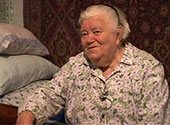
Maria Yakuta was born in 1921 in Teplyk. She grew up with six siblings. Her parents were also born in Teplyk, and her father worked as a hatmaker. She attended a Yiddish school for seven years. Her parents and three siblings were killed in Teplyk during the war.
Other Interviews:
"Der Shtern"Peeking into the Men's Section
The Binding of Isaac
The Matzo Bag
Eating Sour Mash - the Great Hunger
Sanctification of the Moon
“and a goat on a chain”
Teplyk, Ukraine
Between 1928 and 1933, the period of the First Five-Year Plan, the Soviet Union underwent a radical transformation from a mixed economy to a planned one: the state outlawed all private capital and launched a massive campaign to promote heavy industry and collectivized farming.
The increased intrusion of the Soviet state into the shtetl was so transformative that people often indicate this break by referring to the post-1933 era as “the Soviet regime” in contrast to the earlier decade, during which the Soviet government had not yet fully infiltrated the
shtetl. This popular periodization reflects the real difficulties the Soviet central government had in establishing full control over the small towns in Ukraine. Prior to what many people refer to as “the Soviet regime” the impact of Soviet institutions and policies was limited. Certainly for those who paid attention to politics, the communist government was instituting numerous changes, but for ordinary folk who struggled on a day-to-day basis to make ends meet, the period before the early 1930s was characterized only by economic insecurity, and at least in the initial revolutionary years, a dizzying array of governments that came and left.
For about fifteen years following the Bolshevik Revolution in faraway Petrograd, the struggle for food security, shelter, and survival continued unabated in small-town Ukraine. It was only during the 1930s that the region began to pull its way out of poverty and slowly transform itself into a modern industrialized region, just in time for a new devastation, whose terrors would completely
surpass the Civil War and pogroms of that earlier era. In Ukraine, collectivization and dekulakization were the most invasive effects of the First Five-Year Plan, radically transforming the Ukrainian countryside.
In addition to the subjugation of the peasantry, though, collectivization unleashed a wave of repression against individuals the state believed facilitated the peasant economy: priests, village elites, private traders, and the petty intelligentsia.34 Repressive policies were replicated in urban centers, where religious functionaries, including rabbis and Jewish elites, were persecuted together with merchants and small shop-owners, who were accused of aiding the kulaks and preventing grain distribution. In short, those who had managed to sustain the economy during the first decade of the Revolution were rewarded for their efforts with arrests and expulsion.
One target of the Teplyk collectivization drive was Maria Yakuta’s uncle, Khotskl. She remembered that Khotskl had a goat, and thus was able to get milk whenever he wanted. This was a luxury in Teplyk during the 1920s, and reason enough for the children to visit Khotskl as often as possible: “He would welcome us with dumplings and milk. It was so delicious.” Khotskl’s goat and the “luxurious” lifestyle he enjoyed with his dumplings and milk attracted the attention of the authorities, who were hunting “kulaks.” Most of Khotskl’s meager wealth came from his small shop: “My mother’s brother had a small shop. There were pencils there and notebooks and herring, kerosene, candles. It was a poor little shop, a little canteen. And he was a pauper with a big family.” But since he personally owned his shop, he was regarded as a speculator, an enemy of the people. As Yakuta explained, “The president of the Jewish government, Stratievski, was given the task of collecting gold from the Jews. He searched my uncle, Khotskl—his name was Khotskl Vitniatski. And he was arrested. He didn’t have any money. He was thrown in prison. He was left there for an entire winter; his beard was overtaken by lice. He barely made it out of there alive. It wasn’t just his money they were after but also that of his brothers. They wanted him to sell out his family.”
Yakuta was indignant that Khotskl was targeted as one of the moneyed elite, when he had so little with which to feed his family: “They were all very poor people. Who were the Jews with money?! Those who had a business with large stores, or large businesses of course. But he just had buckwheat dumplings boiled in milk. And a goat on a chain.”
Source: Jeffrey Veidlinger, In the Shadow of the Shtetl: Small-Town Jewish Life in Soviet Ukraine (Indiana University Press, 2013)
